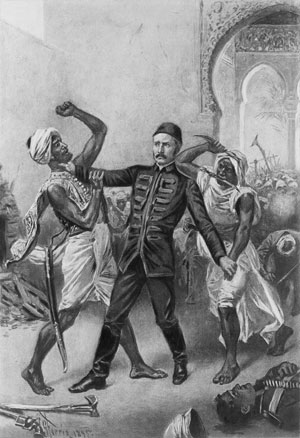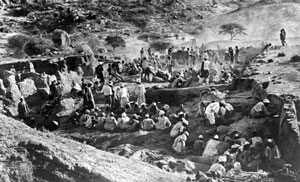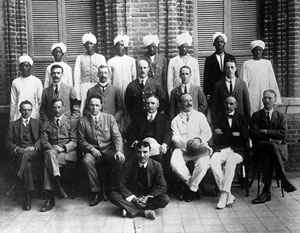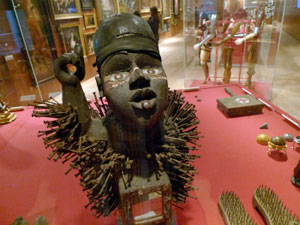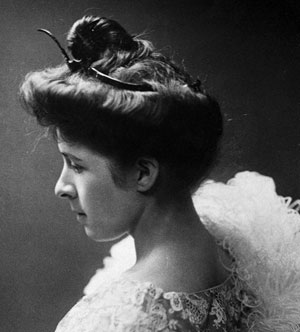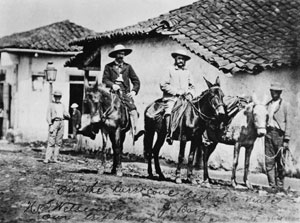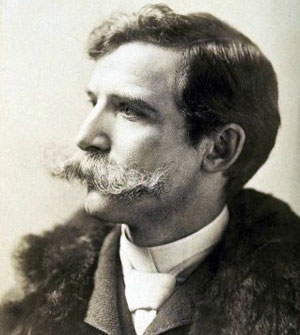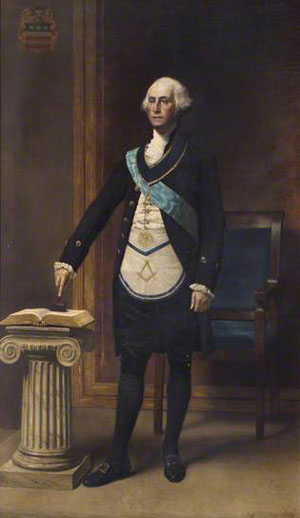Medicine Man … and Freemason
The famous American / British pharmaceutical entrepreneur, Sir Henry Solomon Wellcome's beginnings were somewhat humble. He was born, on 21 August 1853, in a frontier log cabin in Almond, Wisconsin, the second son of Rev. Solomon C. Wellcome, an itinerant missionary who travelled in, and preached from, a covered wagon. As a child, Henry was once tasked with making bullets while his family was besieged by Sioux Indians in Garden City, Minnesota!
Henry's 17th century ancestors were French Protestants with the surname, Bienvenue. They fled religious persecution to seek asylum in England, where they anglicised their name to Wellcome, and in 1640, emigrated to New England and settled in Massachusetts.
From early in his life Henry Wellcome had an interest in medicine - and marketing. His first saleable 'product' was invisible ink (in reality pure lemon juice) which he sold via advertisements placed in the local Garden City Herald newspaper. He was just 16.
He travelled extensively but, aged 27; he was summoned by his college friend Silas Mainville Burroughs, and finally left his native United States to journey to London and form a new pharmaceutical company, Burroughs Wellcome. The firm flourished from the start marketing, and later manufacturing, American medicines in the form of compressed tablets. (At this period most medicines could only be purchased as liquids or powders, so Burroughs Wellcome's trademarked 'Tabloid' tablets were quite a novel and convenient method of taking prescription drugs. Curiously, Henry was the first man to coin the word 'tabloid'.)
His partnership with Silas Burroughs unfortunately ran into difficulties within two years of its formation and in 1889 litigation ensued, culminating in a court case that found in favour of Henry Wellcome. Notwithstanding the tensions between them, the company continued to go from strength-to-strength, eventually listing among its clientele, Haile Selassie, Robert Falcon Scott and King Edward VII. When Burroughs died unexpectedly from pneumonia in 1895, Wellcome found himself in total control of a highly profitable enterprise and able to implement his many whims - scientific and philanthropic - unfettered by financial or other restrictions.
Toward the end of the 19th and beginning of the 20th centuries, Victorian England was captivated by events and news from the 'mysterious continent' of Africa and Henry Wellcome had the flair - and the money - to do something practical for Africa. By 1884 he had met, and become close friends with the explorer, Henry Stanley, with whom he had a great deal in common. It was this friendship that was largely responsible for Wellcome's boundless fascination for Africa. The Sudan, however, had been placed in chaos by a long period of political unrest and religious war. In 1885 the British General, Charles Gordon, had been killed in Khartoum by fanatics loyal to Islamist leader, Muhammad Ahmed (the self-styled Mahdi), and when a new Anglo-Sudanese War broke out Lord Kitchener was ordered to restore order and British and Egyptian rule. On 2nd September 1898, armed with artillery pieces, the new Maxim machine gun and Lee Metford bolt-action rifles, the allied force of 8,200 British and 17,600 Egyptian soldiers met the 52,000 warriors of the Mahdi's successor, 'Khalifa' Abdullah al-Taashi, at the Battle of Omdurman. (It was during Omdurman that a young Winston Churchill experienced his first combat.) By the day's end the British-Egyptian force had suffered 47 dead and 382 wounded, the Khalifa's followers on the other hand, had suffered 10,000 killed, 13,000 wounded and 5,000 captured – a horrendous defeat, but the Khalifa himself had escaped. Having pursued his quarry for a year, Kitchener ordered Sir Francis Reginald Wingate to advance on the remaining forces of the rebellious Khalifa and, on 25 November 1899, they clashed at the Battle of Umm Diwaykarat. The Khalifa Abdullah and 3,000 of his followers were killed, thus paving the way for an agreement to be brokered between Britain and Egypt to restore stability, and Egyptian rule, in the Sudan. The victorious Lord Herbert Kitchener (whom Wellcome latterly met) was also an enthusiastic Freemason, and he was simultaneously appointed Governor-General of the Sudan, and the first Masonic District Grand Master of Egypt and the Sudan.
With relative peace restored, Henry Wellcome was now free to pursue his scientific, archaeological and philanthropic interests in the region. In December 1899, Wingate took over the Governorship from Kitchener and from then on much of Wellcome's activities were coordinated with Wingate's patronage. Henry Wellcome's first visit to the Sudan left such a strong impression on him that he spent a total of 14 years active in the region, establishing the Gordon Memorial College in Khartoum, and founding the Wellcome Tropical Research Laboratories there which, at the time, placed Sudan in the forefront of research into tropical diseases.
Henry Wellcome was an enthusiastic collector and keen archaeologist. His interests in the Sudan and Egypt extended to archaeological digs, most famously at Jebel-Moya in the Sudan, where he hired over 4,000 people to excavate over a period of several years. Notwithstanding some controversy as to his treatment of the native workers, he was popularly known as Al Pasha by the local inhabitants.
His main collecting passion though, was actually for medically related artefacts, and he acquired a vast collection of scientific items, books and instruments – many of which are now on display in the Wellcome Gallery of the Science Museum in London or the Wellcome Institute Library. The size of the Wellcome collection is astounding. Henry seemed to buy everything in sight that had anything remotely to do with medicine. His collection includes Charles Darwin's walking stick, Florence Nightingale's slippers, the death masks of Disraeli and Beethoven, and even Napoleon Bonaparte's toothbrush! At the time of his death, it consisted of over one million objects - 125,000 of these were medically linked and formed part of the permanent collection. The remainder, including his Masonic possessions, were dispersed after his death by gift, both to other Museums and by auction. In one instance, on 21 March 1938, Harrods, Allsop & Co auctioned "by order of the trustees of the late Sir Henry Wellcome," a total of nearly 200 books on Freemasonry in 11 lots (numbers 95 to 106). These included a first edition of Anderson's Constitutions of 1723, a 1745 edition of the French Exposure Ordre Des Franc-Maçon Trahi, a 1691 edition of a Knights Templar volume, and many other classical works. All were purchased by one buyer, identified only as Marks, for £4.10s – an absolute bargain.
It was in Khartoum in 1901 that Henry Wellcome met the beautiful, if somewhat impulsive, Gwendoline Maud Syrie Barnardo and almost immediately fell in love with her. Syrie was travelling with her father, Dr Thomas Barnardo (SEE MASONIC QUARTERLY MAGAZINE, ISSUE 20), the famous Freemason and founder of Barnardo's Homes for orphan children – he was an old friend of Henry's. Syrie was 21, and thus 27 years Henry's junior. They married very soon thereafter and had one child, Henry Mounteney Wellcome.
Initially all was well but their interests, stressed by their age difference, were at opposite ends of the social spectrum. Henry was energetic, enjoyed sport and travel, whilst Syrie preferred sedentary socialising in the sophisticated parlours and drawing-rooms of London. Meanwhile their son (who lived into his eighties), was born with mild brain-damage and a learning disability that kept him apart from his family from the age of three. Unable to identify with her husband's work and activities, and unhappy travelling with him, Syrie was soon having affairs, one of which is reputed to have included, the American-born magnate, Harry G. Selfridge, of department store fame. In 1909, following a major argument, Henry and Syrie decided to separate. Syrie left for New York and they never saw each other again. In an attempt to keep any scandal out of the press, Henry agreed to a generous financial settlement. He was, however, outraged by Syrie's relationship with the writer William Somerset Maugham, a known homosexual. In Rome, Syrie bore Maugham a daughter and called her Mary Elizabeth. From birth, the child's nickname was 'Liza', the heroine of Maugham's first bestselling novel, Liza of Lambeth.
By 1915 the exasperated Wellcome commenced proceedings that culminated in a divorce in February 1916: he cited Maugham as co-respondent. The case was uncontested and Syrie gained custody of the child. Within three months she was secretly married to Somerset Maugham in New Jersey on 16 May 1916. They too, however, divorced in 1928 due to Maugham's continued philandering with a long-term male companion, Gerald Haxton. An enormous amount of unwanted press attention brought intimate details into the public arena. Syrie claimed that Henry treated her with "brutality", neglecting her with his endless travelling and his excessive Masonic activities. At the end, unsurprisingly, Henry left her nothing in his estate, although he gave £500 to Dr. Barnardo's Homes for Children.
Bearing in mind his ancestry; it was almost natural for Henry to adopt England as his mother country. He was nationalised in 1910, and following many other honours, knighted in 1932, and he died, aged 82, in London on 25th July 1936.
There can be no doubt that Henry Wellcome was a remarkable man with many facets to his complex character: a scientist, businessman, philanthropist, archaeologist, collector and Freemason. He left behind a legacy that has immortalised his name in each of the fields in which he excelled with equal success. Nowadays, though, he is remembered only on the periphery of science. The Wellcome Trust, however, is a world renowned charitable trust, the largest in the UK. It was established, as required in his will, as an independent research-funding charity, for humans and animals, upon his death in 1936. Today it administers $600 million USD in grants each year to a variety of medical research projects.
Henry Wellcome was obviously a sensitive soul, but his acumen in business still shines, if no longer in his name. In March 1995, Glaxo took over Burroughs Wellcome & Company for the enormous sum of £9.4 billion British Pounds ($15,020,000,000 USD), in what was then the biggest merger in UK corporate history. In January 2000, Glaxo Wellcome announced its merger with SmithKline Beecham thus forming the world's largest pharmaceutical company.
Henry Wellcome's membership of the Craft
Wellcome's business partner, Silas Burroughs was a Freemason who had been initiated into Clapham Lodge No. 1818, UGLE, but more importantly, Burroughs had employed as an accountant an English Freemason of standing and ability, Robert Clay Sadlow, and it was he with whom Wellcome developed a life-long friendship. It was also Sadlow who brought Henry into Freemasonry.
It is a reflection of Wellcome's enthusiasm for Freemasonry, that during the most troublesome periods in his life, he pursued his Masonic activity well beyond its basic requirements and principles. He was initiated into Lodge of Fidelity No. 3 on 11th February 1885, and his passing and raising ceremonies, (which were also carried out in 1885 by Robert Sadlow), were reportedly at Eastes Lodge No. 1965. On 19 March 1891, Henry Wellcome was the founding Senior Deacon of Columbia Lodge No. 2397 (He resigned in 1904.), and a year later he was serving as Master of his Mother Lodge. This is the year that he extended his Masonic activities beyond Craft Masonry.
He was exalted into the Royal Arch in the Old King Arms Chapter No. 28 on 4th April 1892 and advanced in the Mark a year later. He was elected Master of Hiram Lodge of Mark Master Masons No. 13 on 25 March 1896, exactly three years after his advancement. He resigned the Mark in 1904.
On 9 November 1894, he was perfected into Tuscan Chapter No. 129 of the Ancient and Accepted (Scottish) Rite (Rose Croix), reaching the 30th Degree in that Order in July 1898. Rather unusually, he only became Sovereign eight years later, in August 1906 (possibly due to his Sudanese commitments) and resigned from this Order too in 1920. He was also installed a Knights Templar in 1893, taking the Malta Degree in May 1895. By now he had become Master of the Columbia Lodge, in a ceremony again conducted by his good friend Robert Sadlow. This followed on his duties as First Principal of the Old King Arms Chapter, in 1897, the year of the foundation of the Columbia Chapter in which he was Second Principal.
In 1890, he also became an honorary member of Savage Club Lodge No. 2190. Notwithstanding all this intense Masonic activity, his enthusiasm and devotion to the Craft during these two decades is most manifest in the extra-curricular activities associated with the unattached Clarence Lodge of Instruction in which he was elected Treasurer in 1893, a post that he actively filled until 1904. The Clarence Lodge of Instruction was founded by members of the Bank of England Lodge and was, effectively, a daughter Lodge to the well-known and long-standing 'Emulation Lodge of Improvement' that still performs its duties today - teaching the perfection of the English Constitution's Masonic ritual - from its base at Freemasons' Hall in Holborn, London.
In line with his impulsive, even if resolute, nature Wellcome's Masonic interests waned after the highly concentrated period in which he had been so intensely active. It is thought that a specific incident may have triggered something in his sensitive nature to cause his gradual resignation from particular Lodges and general withdrawal from Freemasonry. There was though, one last gesture of lasting Masonic consequence on his part, when he gifted the impressive life-size painting of George Washington, dressed in Masonic garb, to the United Grand Lodge of England (UGLE). It hangs in the first floor lounge at Freemasons' Hall in London.
George Washington died in 1799 and, as the centenary of his death approached, Henry Wellcome offered Grand Lodge the portrait, which was gladly accepted. There was a delay due to the low quality of the first painting, and Wellcome commissioned the well-known American portrait artist Robert Gordon Hardie (1854-1904) to copy it, writing to him on 2nd December 1901: "I feel that by changing my original plan you will have much greater scope in painting a really masterful picture, which I am sure you will take great pride in doing. If you think it desirable to introduce Washington's coat of arms (which contain the stars and stripes) you might do so. "There are a great many portraits of Washington, which are excessively bad, and make him look more like George III than the true Washington. What is wanted in this picture is the type of Washington which you and I have known all our lives – our ideal! The great, wise and highly spiritual Washington – the true father of our country." On Friday, 8 August 1902, the painting was formally unveiled by the American Ambassador, Joseph H. Choate, in the presence of the Earl of Warwick, Deputy Grand Master of the U.G.L.E., and a small gathering of Brethren in the library of Freemasons' Hall. Among others present were J. R. Robertson, Past Grand Master of Canada, Sir J. Puleston, Alderman F. Trehawke, Colonel Daly, District Grand Master of British Guiana, as well as Henry Sadler, the Grand Tyler and Clay Sadlow and Henry Wellcome himself.
The portrait of George Washington is in the dress of the period featuring his full Masonic regalia and, as requested, in the corner are the arms of the Washington family, which are the origin of the iconic American stars and stripes. It is a permanent and public reminder of, and memorial to, Wellcome's remarkable life, his generosity and close involvement with Freemasonry.
WITH THANKS AND DUE ACKNOWLEDGEMENT TO THE WORK, RESEARCH AND COPYRIGHTS OF:
R.W.BRO. YASHA BERESINER LL.B. PM QUATUOR CORONATI NO. 2076, UGLE AND MASONIC QUARTERLY MAGAZINE, UK – NOW TITLED 'FREEMASONRY TODAY', THE OFFICIAL PUBLICATION OF THE UNITED GRAND LODGE OF ENGLAND. www.freemasonrytoday.com
THE WELLCOME COLLECTION - PHOTOGRAPHS COPYRIGHT © THE WELLCOME TRUST
AND
WWW.EN.WIKIPEDIA.ORG
AND
PORTRAIT OF GEORGE WASHINGTON:
COPYRIGHT © THE LIBRARY AND MUSEUM OF FREEMASONS' HALL, HOLBORN, LONDON.



